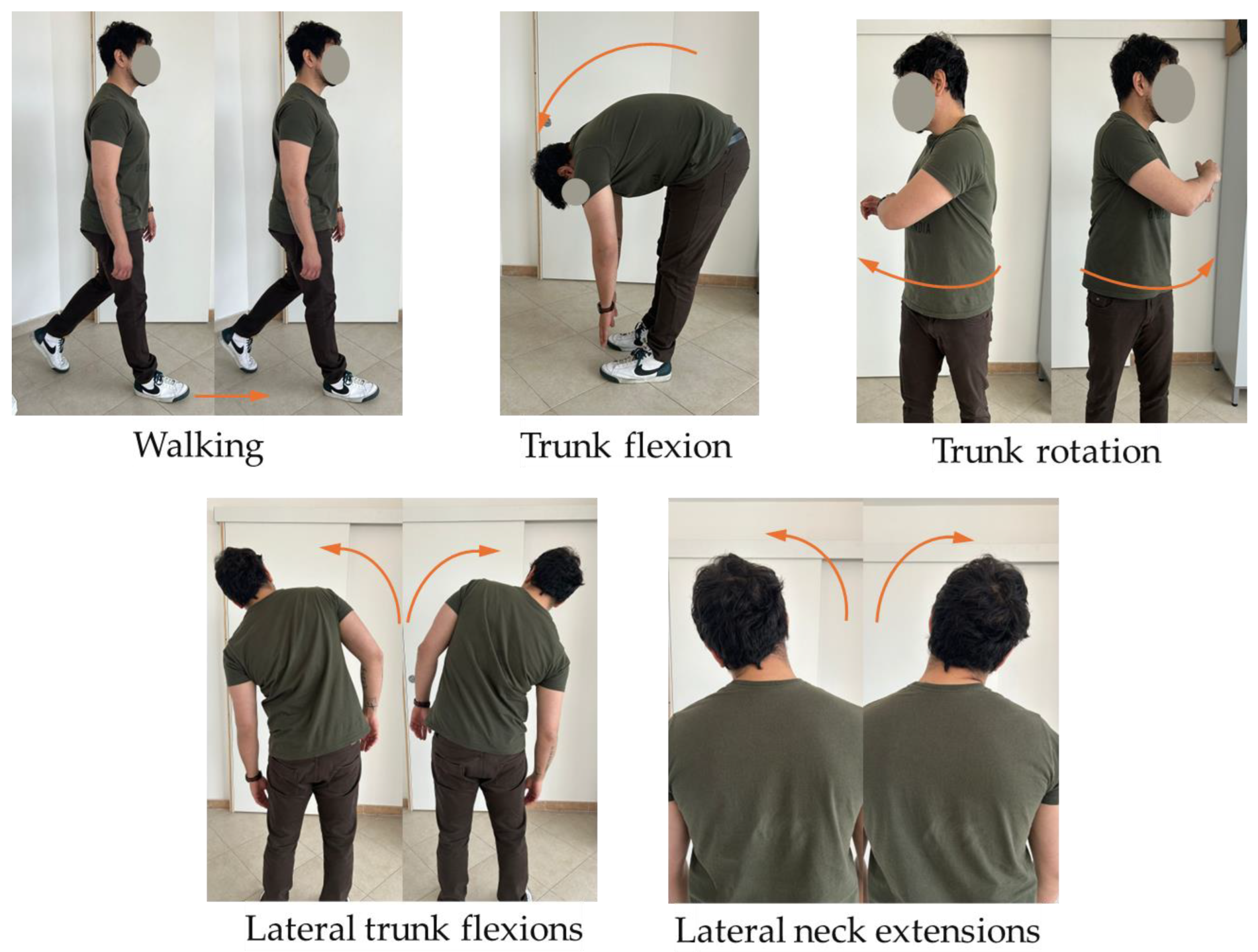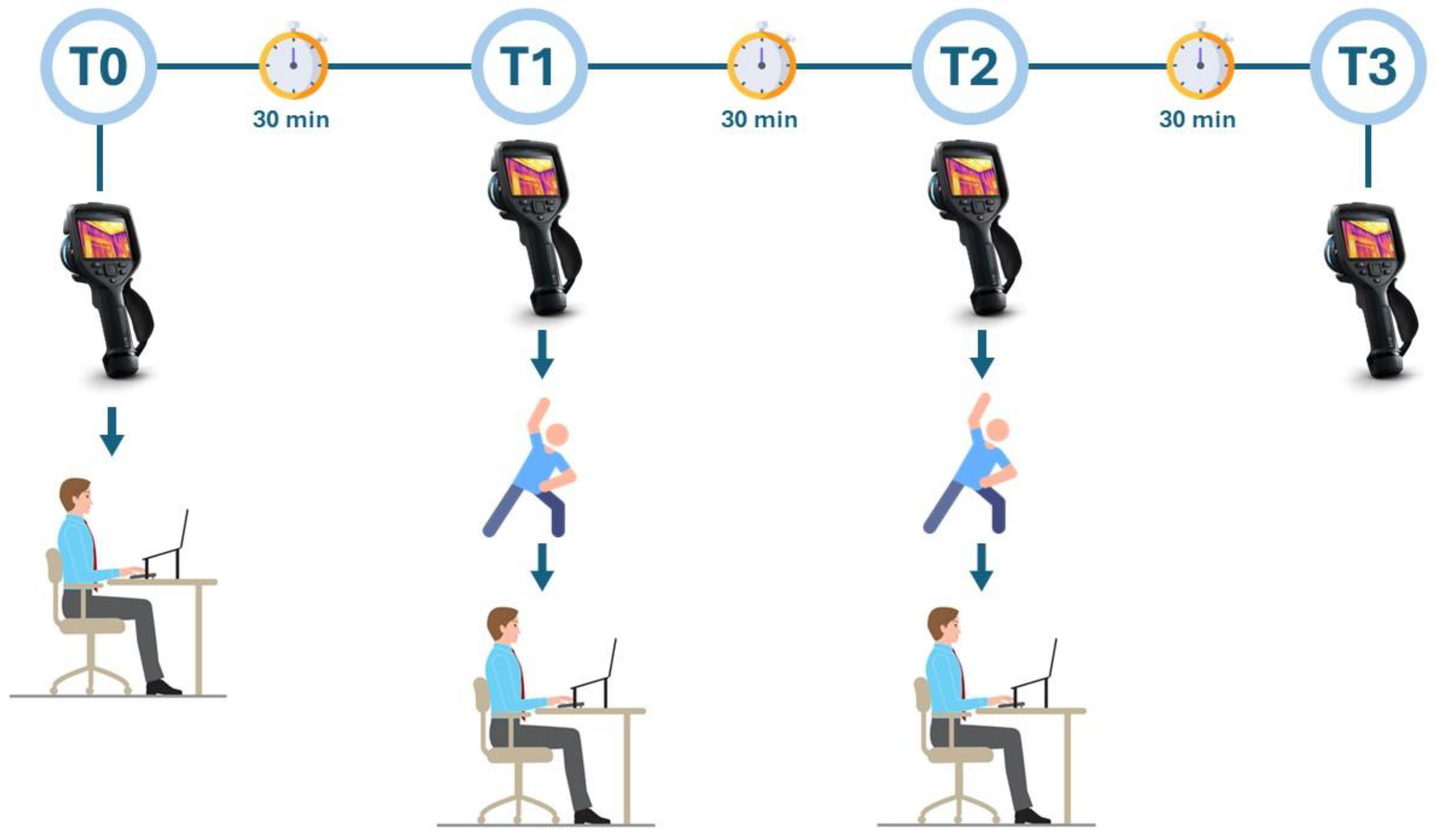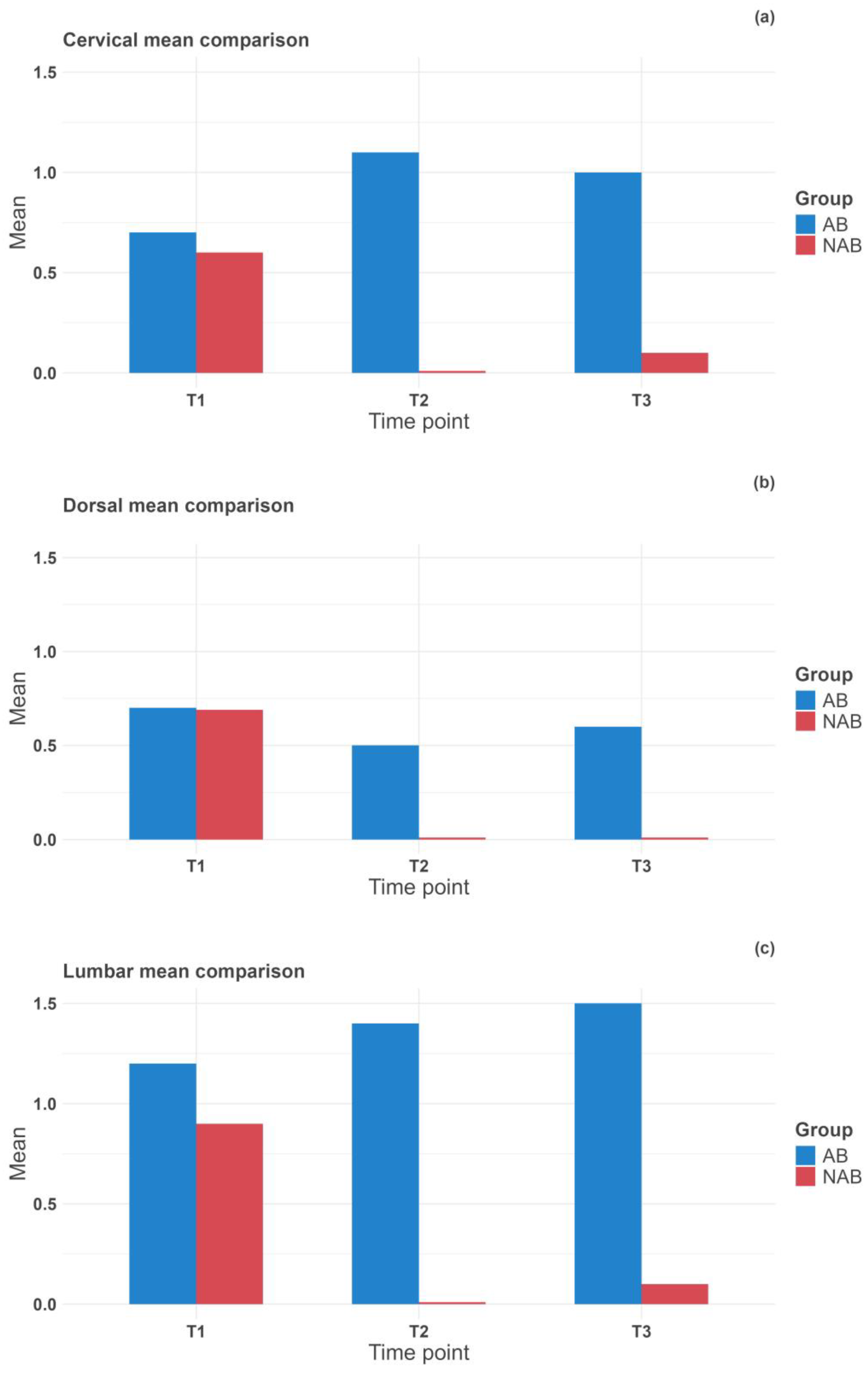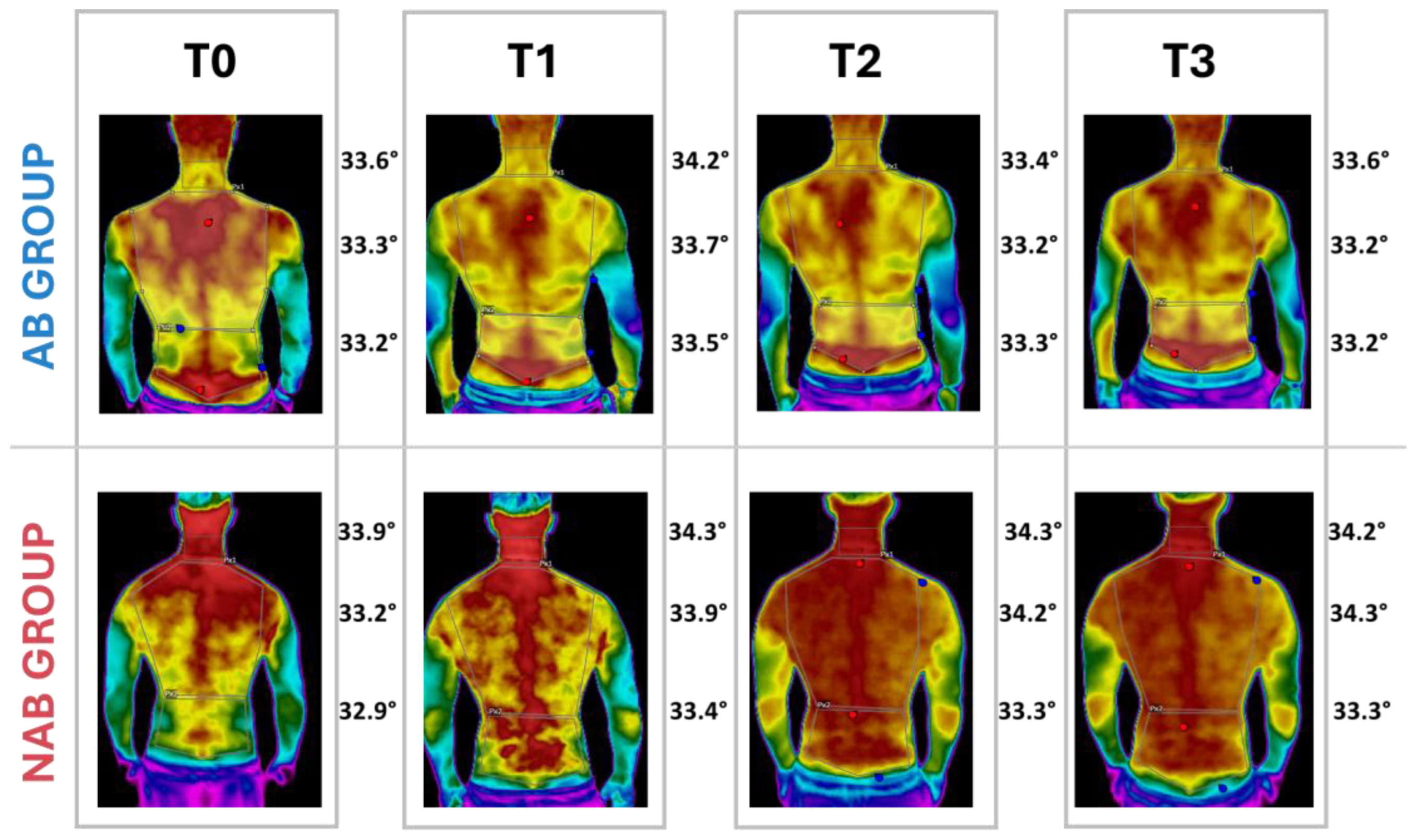Active Breaks Reduce Back Overload during Prolonged Sitting: Ergonomic Analysis with Infrared Thermography
Abstract
1. Introduction
2. Materials and Methods
2.1. Physical Activity Protocol
2.2. Infrared Thermography
2.3. Statistical Analysis
3. Results
4. Discussion
5. Conclusions
Author Contributions
Funding
Institutional Review Board Statement
Informed Consent Statement
Data Availability Statement
Conflicts of Interest
References
- da Silva, W.; Machado, Á.S.; Kunzler, M.R.; Jimenez-Perez, I.; Gil-Calvo, M.; Priego-Quesada, J.I.; Carpes, F.P. Reproducibility of skin temperature analyses by novice and experienced evaluators using infrared thermography. J. Therm. Biol. 2022, 110, 103345. [Google Scholar] [CrossRef] [PubMed]
- Costa, C.M.; Sillero-Quintana, M.; Piñonosa Cano, S.; Moreira, D.G.; Brito, C.J.; Fernandes, A.A.; Pussieldi, G.A.; Marins, J.C. Daily oscillations of skin temperature in military personnel using thermography. J. R. Army Med. Corp. 2016, 162, 335–342. [Google Scholar] [CrossRef] [PubMed]
- Tattersall, G.J. Infrared thermography: A non-invasive window into thermal physiology. Comp. Biochem. Physiol. A Mol. Integr. Physiol. 2016, 202, 78–98. [Google Scholar] [CrossRef] [PubMed]
- Jones, B.F.; Plassmann, P. Digital infrared thermal imaging of human skin. IEEE Eng. Med. Biol. Mag. 2002, 21, 41–48. [Google Scholar] [CrossRef] [PubMed]
- Perpetuini, D.; Formenti, D.; Cardone, D.; Filippini, C.; Merla, A. Regions of interest selection and thermal imaging data analysis in sports and exercise science: A narrative review. Physiol. Meas. 2021, 42, 08TR01. [Google Scholar] [CrossRef] [PubMed]
- Zaproudina, N.; Varmavuo, V.; Airaksinen, O.; Närhi, M. Reproducibility of infrared thermography measurements in healthy individuals. Physiol. Meas. 2008, 29, 515–524. [Google Scholar] [CrossRef] [PubMed]
- da Silva, H.K.V.; Oliveira, M.C.E.; Silva-Filho, E.; Magalhães, A.G.; Correia, G.N.; Micussi, M. Evaluation of the female pelvic floor with infrared thermography: A cross sectional study. Braz. J. Phys. Ther. 2022, 26, 100390. [Google Scholar] [CrossRef] [PubMed]
- Barbosa, J.S.; Amorim, A.; Arruda, M.; Medeiros, G.; Freitas, A.; Vieira, L.; Melo, D.P.; Bento, P.M. Infrared thermography assessment of patients with temporomandibular disorders. Dento Maxillo Facial Radiol. 2020, 49, 20190392. [Google Scholar] [CrossRef] [PubMed]
- Kuznia, A.L.; Hernandez, A.K.; Lee, L.U. Adolescent Idiopathic Scoliosis: Common Questions and Answers. Am. Fam. Physician 2020, 101, 19–23. [Google Scholar]
- Besharati, A.; Daneshmandi, H.; Zareh, K.; Fakherpour, A.; Zoaktafi, M. Work-related musculoskeletal problems and associated factors among office workers. Int. J. Occup. Saf. Ergon. JOSE 2020, 26, 632–638. [Google Scholar] [CrossRef] [PubMed]
- Trovato, B.; Roggio, F.; Sortino, M.; Rapisarda, L.; Petrigna, L.; Musumeci, G. Thermal profile classification of the back of sportive and sedentary healthy individuals. J. Therm. Biol. 2023, 118, 103751. [Google Scholar] [CrossRef]
- Roggio, F.; Petrigna, L.; Trovato, B.; Zanghì, M.; Sortino, M.; Vitale, E.; Rapisarda, L.; Testa, G.; Pavone, V.; Pavone, P.; et al. Thermography and rasterstereography as a combined infrared method to assess the posture of healthy individuals. Sci. Rep. 2023, 13, 4263. [Google Scholar] [CrossRef] [PubMed]
- Mi, B.H.; Zhang, W.Z.; Xiao, Y.H.; Hong, W.X.; Song, J.L.; Tu, J.F.; Jiang, B.Y.; Ye, C.; Shi, G.X. An exploration of new methods for metabolic syndrome examination by infrared thermography and knowledge mining. Sci. Rep. 2022, 12, 6377. [Google Scholar] [CrossRef] [PubMed]
- Wang, X.; Chou, K.; Zhang, G.; Zuo, Z.; Zhang, T.; Zhou, Y.; Mao, F.; Lin, Y.; Shen, S.; Zhang, X.; et al. Breast cancer pre-clinical screening using infrared thermography and artificial intelligence: A prospective, multicentre, diagnostic accuracy cohort study. Int. J. Surg. 2023, 109, 3021–3031. [Google Scholar] [CrossRef] [PubMed]
- De Marziani, L.; Boffa, A.; Angelelli, L.; Andriolo, L.; Di Martino, A.; Zaffagnini, S.; Filardo, G. Infrared Thermography in Symptomatic Knee Osteoarthritis: Joint Temperature Differs Based on Patient and Pain Characteristics. J. Clin. Med. 2023, 12, 2319. [Google Scholar] [CrossRef]
- Schiavon, G.; Capone, G.; Frize, M.; Zaffagnini, S.; Candrian, C.; Filardo, G. Infrared Thermography for the Evaluation of Inflammatory and Degenerative Joint Diseases: A Systematic Review. Cartilage 2021, 13, 1790s–1801s. [Google Scholar] [CrossRef] [PubMed]
- Adamovich, S.V.; Fluet, G.G.; Tunik, E.; Merians, A.S. Sensorimotor training in virtual reality: A review. NeuroRehabilitation 2009, 25, 29–44. [Google Scholar] [CrossRef] [PubMed]
- Roggio, F.; Petrigna, L.; Filetti, V.; Vitale, E.; Rapisarda, V.; Musumeci, G. Infrared thermography for the evaluation of adolescent and juvenile idiopathic scoliosis: A systematic review. J. Therm. Biol. 2023, 113, 103524. [Google Scholar] [CrossRef] [PubMed]
- Yabunaka, K.; Hayashi, N.; Furumitsu, Y.; Ohno, Y.; Matsuzaki, M.; Yamauchi, S. Infrared Thermography and Ultrasonography of the Hands in Rheumatoid Arthritis Patients. J. Med. Ultrasound 2021, 29, 212–214. [Google Scholar] [CrossRef] [PubMed]
- Zaproudina, N.; Ming, Z.; Hänninen, O.O. Plantar infrared thermography measurements and low back pain intensity. J. Manip. Physiol. Ther. 2006, 29, 219–223. [Google Scholar] [CrossRef]
- Machado, Á.S.; da Silva, W.; Priego-Quesada, J.I.; Carpes, F.P. Can infrared thermography serve as an alternative to assess cumulative fatigue in women? J. Therm. Biol. 2023, 115, 103612. [Google Scholar] [CrossRef]
- Gómez-Carmona, P.; Fernández-Cuevas, I.; Sillero-Quintana, M.; Arnaiz-Lastras, J.; Navandar, A. Infrared Thermography Protocol on Reducing the Incidence of Soccer Injuries. J. Sport Rehabil. 2020, 29, 1222–1227. [Google Scholar] [CrossRef] [PubMed]
- Patti, A.; Thornton, J.S.; Giustino, V.; Drid, P.; Paoli, A.; Schulz, J.M.; Palma, A.; Bianco, A. Effectiveness of Pilates exercise on low back pain: A systematic review with meta-analysis. Disabil. Rehabil. 2023. [Google Scholar] [CrossRef] [PubMed]
- Carter, S.; Hartman, Y.; Holder, S.; Thijssen, D.H.; Hopkins, N.D. Sedentary Behavior and Cardiovascular Disease Risk: Mediating Mechanisms. Exerc. Sport Sci. Rev. 2017, 45, 80–86. [Google Scholar] [CrossRef]
- Global burden of 369 diseases and injuries in 204 countries and territories, 1990–2019: A systematic analysis for the Global Burden of Disease Study 2019. Lancet 2020, 396, 1204–1222. [CrossRef] [PubMed]
- Marshall, S.; Gyi, D. Evidence of health risks from occupational sitting: Where do we stand? Am. J. Prev. Med. 2010, 39, 389–391. [Google Scholar] [CrossRef] [PubMed]
- Soranso, D.R.; Minette, L.J.; Marçal, M.; Marins, J.C.B.; Schettino, S.; Lima, R.C.A.; Oliveira, M. Thermography in ergonomic assessment: A study of wood processing industry workers. PeerJ 2022, 10, e13973. [Google Scholar] [CrossRef] [PubMed]
- Luximon, A.; Chao, H.; Goonetilleke, R.S.; Luximon, Y. Theory and applications of InfraRed and thermal image analysis in ergonomics research. Front. Comput. Sci. 2022, 4, 990290. [Google Scholar] [CrossRef]
- Gerr, F.; Marcus, M.; Ensor, C.; Kleinbaum, D.; Cohen, S.; Edwards, A.; Gentry, E.; Ortiz, D.J.; Monteilh, C. A prospective study of computer users: I. Study design and incidence of musculoskeletal symptoms and disorders. Am. J. Ind. Med. 2002, 41, 221–235. [Google Scholar] [CrossRef] [PubMed]
- van der Ploeg, H.P.; Møller, S.V.; Hannerz, H.; van der Beek, A.J.; Holtermann, A. Temporal changes in occupational sitting time in the Danish workforce and associations with all-cause mortality: Results from the Danish work environment cohort study. Int. J. Behav. Nutr. Phys. Act. 2015, 12, 71. [Google Scholar] [CrossRef]
- Vitoulas, S.; Konstantis, V.; Drizi, I.; Vrouva, S.; Koumantakis, G.A.; Sakellari, V. The Effect of Physiotherapy Interventions in the Workplace through Active Micro-Break Activities for Employees with Standing and Sedentary Work. Healthcare 2022, 10, 2073. [Google Scholar] [CrossRef] [PubMed]
- Scaturro, D.; Rizzo, S.; Sanfilippo, V.; Giustino, V.; Messina, G.; Martines, F.; Falco, V.; Cuntrera, D.; Moretti, A.; Iolascon, G.; et al. Effectiveness of Rehabilitative Intervention on Pain, Postural Balance, and Quality of Life in Women with Multiple Vertebral Fragility Fractures: A Prospective Cohort Study. J. Funct. Morphol. Kinesiol. 2021, 6, 24. [Google Scholar] [CrossRef] [PubMed]
- Ding, Y.; Cao, Y.; Duffy, V.G.; Zhang, X. It is Time to Have Rest: How do Break Types Affect Muscular Activity and Perceived Discomfort During Prolonged Sitting Work. Saf. Health Work 2020, 11, 207–214. [Google Scholar] [CrossRef] [PubMed]
- Burdorf, A.; Naaktgeboren, B.; de Groot, H.C. Occupational risk factors for low back pain among sedentary workers. J. Occup. Med. 1993, 35, 1213–1220. [Google Scholar] [PubMed]
- Zemp, R.; Fliesser, M.; Wippert, P.M.; Taylor, W.R.; Lorenzetti, S. Occupational sitting behaviour and its relationship with back pain—A pilot study. Appl. Ergon. 2016, 56, 84–91. [Google Scholar] [CrossRef] [PubMed]
- Vergara, M.; Page, A. Relationship between comfort and back posture and mobility in sitting-posture. Appl. Ergon. 2002, 33, 1–8. [Google Scholar] [CrossRef]
- Ludwig, N.; Formenti, D.; Gargano, M.; Alberti, G. Skin temperature evaluation by infrared thermography: Comparison of image analysis methods. Infrared Phys. Technol. 2014, 62, 1–6. [Google Scholar] [CrossRef]
- Bartuzi, P.; Roman-Liu, D.; Wiśniewski, T. The influence of fatigue on muscle temperature. Int. J. Occup. Saf. Ergon. JOSE 2012, 18, 233–243. [Google Scholar] [CrossRef] [PubMed]
- Waongenngarm, P.; Rajaratnam, B.S.; Janwantanakul, P. Internal Oblique and Transversus Abdominis Muscle Fatigue Induced by Slumped Sitting Posture after 1 Hour of Sitting in Office Workers. Saf. Health Work 2016, 7, 49–54. [Google Scholar] [CrossRef] [PubMed]
- Dindorf, C.; Bartaguiz, E.; Janowicz, E.; Fröhlich, M.; Ludwig, O. Effects of Unilateral Muscle Fatigue on Thermographic Skin Surface Temperature of Back and Abdominal Muscles—A Pilot Study. Sports 2022, 10, 41. [Google Scholar] [CrossRef]
- Travers, P.H.; Stanton, B.-A. Office workers and video display terminals: Physical, psychological and ergonomic factors. AAOHN J. 2002, 50, 489–493. [Google Scholar] [CrossRef] [PubMed]
- Hurwitz, E.L.; Randhawa, K.; Yu, H.; Côté, P.; Haldeman, S. The Global Spine Care Initiative: A summary of the global burden of low back and neck pain studies. Eur. Spine J. 2018, 27, 796–801. [Google Scholar] [CrossRef] [PubMed]
- Albuquerque, N.F.; Lopes, B.S. Musculoskeletal applications of infrared thermography on back and neck syndromes: A systematic review. Eur. J. Phys. Rehabil. Med. 2021, 57, 386–396. [Google Scholar] [CrossRef] [PubMed]
- Radwan, A.; Barnes, L.; DeResh, R.; Englund, C.; Gribanoff, S. Effects of active microbreaks on the physical and mental well-being of office workers: A systematic review. Cogent Eng. 2022, 9, 2026206. [Google Scholar] [CrossRef]
- Davis, K.G.; Kotowski, S.E. Postural variability: An effective way to reduce musculoskeletal discomfort in office work. Hum. Factors 2014, 56, 1249–1261. [Google Scholar] [CrossRef]
- Galinsky, T.; Swanson, N.; Sauter, S.; Dunkin, R.; Hurrell, J.; Schleifer, L. Supplementary breaks and stretching exercises for data entry operators: A follow-up field study. Am. J. Ind. Med. 2007, 50, 519–527. [Google Scholar] [CrossRef] [PubMed]
- Thorp, A.A.; Kingwell, B.A.; Owen, N.; Dunstan, D.W. Breaking up workplace sitting time with intermittent standing bouts improves fatigue and musculoskeletal discomfort in overweight/obese office workers. Occup. Environ. Med. 2014, 71, 765–771. [Google Scholar] [CrossRef] [PubMed]
- Tahernejad, S.; Razeghi, M.; Abdoli-Eramaki, M.; Parsaei, H.; Seif, M.; Choobineh, A. Recommended maximum holding time of common static sitting postures of office workers. Int. J. Occup. Saf. Ergon. 2023, 29, 847–854. [Google Scholar] [CrossRef] [PubMed]
- Proper, K.I.; Koning, M.; van der Beek, A.J.; Hildebrandt, V.H.; Bosscher, R.J.; van Mechelen, W. The effectiveness of worksite physical activity programs on physical activity, physical fitness, and health. Clin. J. Sport Med. 2003, 13, 106–117. [Google Scholar] [CrossRef] [PubMed]
- Parry, S.; Straker, L.; Gilson, N.D.; Smith, A.J. Participatory workplace interventions can reduce sedentary time for office workers—A randomised controlled trial. PLoS ONE 2013, 8, e78957. [Google Scholar] [CrossRef] [PubMed]
- Nooijen, C.F.J.; Blom, V.; Ekblom, Ö.; Heiland, E.G.; Larisch, L.M.; Bojsen-Møller, E.; Ekblom, M.M.; Kallings, L.V. The effectiveness of multi-component interventions targeting physical activity or sedentary behaviour amongst office workers: A three-arm cluster randomised controlled trial. BMC Public Health 2020, 20, 1329. [Google Scholar] [CrossRef]






| Measures | Mean ± SD | |
|---|---|---|
| Men | Women | |
| Age (years) | 34.50 ± 3.40 | 35.13 ± 3.15 |
| Height (cm) | 176.34 ± 5.46 | 164.98 ± 7.25 |
| Weight (kg) | 83.29 ± 11.82 | 67.56 ± 9.03 |
| Measures | Mean ± SD | ||
|---|---|---|---|
| Cervical | Dorsal | Lumbar | |
| T0 NAB | 33.8 ± 0.6 | 33.2 ± 1.0 | 32.4 ± 1.3 |
| T0 AB | 33.8 ± 0.6 | 33.0 ± 0.8 | 32.5 ± 1.2 |
| T1 NAB | 34.3 ± 0.8 | 33.9 ± 0.8 | 33.3 ± 1.1 |
| T1 AB | 34.6 ± 0.6 | 33.8 ± 0.5 | 33.7 ± 0.9 |
| T2 NAB | 34.4 ± 0.9 | 33.9 ± 0.8 | 33.3 ± 1.0 |
| T2 AB | 33.4 ± 1.1 | 33.3 ± 0.7 | 32.3 ± 1.1 |
| T3 NAB | 34.2 ± 1.0 | 33.8 ± 0.8 | 33.3 ± 1.0 |
| T3 AB | 33.6 ± 0.9 | 33.2 ± 0.8 | 32.2 ± 1.1 |
| Group Comparison | Cervical | Dorsal | Lumbar |
|---|---|---|---|
| 1 T0/T1 NAB | 0.0119 * | 0.00335 ** | 0.00236 ** |
| 2 T1/T2 NAB | 0.988 | 0.988 | 0.956 |
| 3 T1/T3 NAB | 0.493 | 0.949 | 0.93 |
| 4 T2/T3 NAB | 0.493 | 0.949 | 0.93 |
| 5 T0/T1 AB | 0.00826 ** | 0.00672 ** | <0.001 *** |
| 6 T1/T2 AB | <0.001 *** | 0.0528 | <0.001 *** |
| 7 T1/T3 AB | <0.001 *** | 0.0274 * | <0.001 *** |
| 8 T2/T3 AB | 0.493 | 0.949 | 0.776 |
| Measures | Mean ± SD | ||
|---|---|---|---|
| Cervical | Dorsal | Lumbar | |
| Δt0-1 NAB | 0.6 ± 0.8 | 0.7 ± 0.7 | 0.9 ± 0.8 |
| Δt0-1 AB | 0.7 ± 0.4 | 0.7 ± 0.6 | 1.2 ± 0.8 |
| Δt1-2 NAB | 0.0 ± 0.4 | 0.0 ± 0.4 | 0.0 ± 0.9 |
| Δt1-2 AB | 1.1 ± 0.9 | 0.5 ± 0.6 | 1.4 ± 0.7 |
| Δt1-3 NAB | 0.1 ± 0.6 | 0.0 ± 0.5 | 0.1 ± 0.6 |
| Δt1-3 AB | 1.0 ± 0.8 | 0.6 ± 0.7 | 1.5 ± 0.8 |
| Group Comparison | Cervical | Dorsal | Lumbar |
|---|---|---|---|
| Δt0-1-NAB/AB | 0.353 | 0.74 | 0.144 |
| Δt1-2-NAB/AB | <0.001 *** | 0.00311 ** | <0.001 *** |
| Δt1-3-NAB/AB | <0.001 *** | 0.00149 ** | <0.001 *** |
Disclaimer/Publisher’s Note: The statements, opinions and data contained in all publications are solely those of the individual author(s) and contributor(s) and not of MDPI and/or the editor(s). MDPI and/or the editor(s) disclaim responsibility for any injury to people or property resulting from any ideas, methods, instructions or products referred to in the content. |
© 2024 by the authors. Licensee MDPI, Basel, Switzerland. This article is an open access article distributed under the terms and conditions of the Creative Commons Attribution (CC BY) license (https://creativecommons.org/licenses/by/4.0/).
Share and Cite
Sortino, M.; Trovato, B.; Zanghì, M.; Roggio, F.; Musumeci, G. Active Breaks Reduce Back Overload during Prolonged Sitting: Ergonomic Analysis with Infrared Thermography. J. Clin. Med. 2024, 13, 3178. https://doi.org/10.3390/jcm13113178
Sortino M, Trovato B, Zanghì M, Roggio F, Musumeci G. Active Breaks Reduce Back Overload during Prolonged Sitting: Ergonomic Analysis with Infrared Thermography. Journal of Clinical Medicine. 2024; 13(11):3178. https://doi.org/10.3390/jcm13113178
Chicago/Turabian StyleSortino, Martina, Bruno Trovato, Marta Zanghì, Federico Roggio, and Giuseppe Musumeci. 2024. "Active Breaks Reduce Back Overload during Prolonged Sitting: Ergonomic Analysis with Infrared Thermography" Journal of Clinical Medicine 13, no. 11: 3178. https://doi.org/10.3390/jcm13113178
APA StyleSortino, M., Trovato, B., Zanghì, M., Roggio, F., & Musumeci, G. (2024). Active Breaks Reduce Back Overload during Prolonged Sitting: Ergonomic Analysis with Infrared Thermography. Journal of Clinical Medicine, 13(11), 3178. https://doi.org/10.3390/jcm13113178








